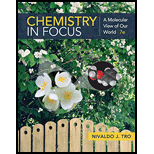
Concept explainers
Interpretation:
The chemical equations are to be balanced for the given reactions.
Concept introduction:
A chemical equation is a symbolic depiction of a
In a chemical reaction, the starting substances on the left side are known as reactants, while the substances on the right side are known as products.
The chemical formula represents the precise number of atoms in a molecule, but not their structural arrangement.
Answer to Problem 52E
Solution: The balanced chemical equation is given as follows:
Explanation of Solution
a)
In the next step,
Now, in the final step,
b)
In the next step,
Now, in the final step,
c)
In the next step,
Now, in the final step,
Want to see more full solutions like this?
Chapter 4 Solutions
Chemistry In Focus
- 3.87 Nitric acid (HNO3) can be produced by the reaction of ni- trogen dioxide (NO2) and water. Nitric oxide (NO) is also formed as a product. Write a balanced chemical equation for this reaction.arrow_forwardThe sugar sucrose, which is present in many fruits and vegetables, reacts in the presence of certain yeast enzymes to produce ethanol and carbon dioxide gas. Balance the following equation for this reaction of sucrose. C12H22O11(aq) + H2O(l) C2H5OH(aq) + CO2(g)arrow_forward3.11 Balance these equations. (a) Al(s) + O2(g)( Al2O3(s) (b) N2(g) + H2(g) (NH3(g) (c) C6H6(l) + O2(g) ( H2O(l) + CO2(g)arrow_forward
- What does it mean to say an equation is balanced? Why is it important for an equation to be balanced?arrow_forwardMethane (CH4) is the main component of marsh gas. Heating methane in the presence of sulfur produces carbon disulfide and hydrogen sulfide as the only products. a. Write the balanced chemical equation for the reaction of methane and sulfur. b. Calculate the theoretical yield of carbon disulfide when 120. g of methane is reacted with an equal mass of sulfur.arrow_forwardBalance the following equations. a Sn + NaOH Na2SnO2 + H2 b Al + Fe3O4 Al2O3 + Fe c CH3OH + O2 CO2 + H2O d P4O111 + H2O H3PO4 e PCl5 + H2O H3PO4 + HClarrow_forward
- 3.18 Diborane and related compounds were proposed as rocket fuels in the 1950s. A representative reaction for this class of molecules is that of B2H6 and O2 to form B2O3 and H2O. Write the balanced chemical equation for this process.arrow_forwardBalance these equations. (a) UO2(s) + HF() UF4(s) + H2O() (b) B2O3(s) + HF() BF3(g) + H2O() (c) BF3(g) + H2O() HF() + H3BO3(s)arrow_forwardConsider the equation 2A + B . A2B. If you mix 1.0 mole of A with 1.0 mole of B, what amount (moles) of A2B can be produced?arrow_forward
- Balance the following equations. a Ca3(PO4)2 + H3PO4 Ca(H2PO4)2 b MnO2 + HCl MnCl2 + Cl2 + H2O c Na2S2O3 + I2 NaI + Na2S4O6 d Al4C3 + H2O Al(OH)3 + CH4 e NO2 + H2O HNO3 + NOarrow_forward4.106 An ore sample with a mass of 670 kg contains 27.7% magnesium carbonate, MgCO3. If all of the magnesium carbonate in this ore sample is decomposed to form carbon dioxide, describe how to determine what mass of CO2 is evolved during the process.arrow_forward
 Chemistry for Engineering StudentsChemistryISBN:9781337398909Author:Lawrence S. Brown, Tom HolmePublisher:Cengage Learning
Chemistry for Engineering StudentsChemistryISBN:9781337398909Author:Lawrence S. Brown, Tom HolmePublisher:Cengage Learning Chemistry: The Molecular ScienceChemistryISBN:9781285199047Author:John W. Moore, Conrad L. StanitskiPublisher:Cengage Learning
Chemistry: The Molecular ScienceChemistryISBN:9781285199047Author:John W. Moore, Conrad L. StanitskiPublisher:Cengage Learning General Chemistry - Standalone book (MindTap Cour...ChemistryISBN:9781305580343Author:Steven D. Gammon, Ebbing, Darrell Ebbing, Steven D., Darrell; Gammon, Darrell Ebbing; Steven D. Gammon, Darrell D.; Gammon, Ebbing; Steven D. Gammon; DarrellPublisher:Cengage Learning
General Chemistry - Standalone book (MindTap Cour...ChemistryISBN:9781305580343Author:Steven D. Gammon, Ebbing, Darrell Ebbing, Steven D., Darrell; Gammon, Darrell Ebbing; Steven D. Gammon, Darrell D.; Gammon, Ebbing; Steven D. Gammon; DarrellPublisher:Cengage Learning Chemistry: An Atoms First ApproachChemistryISBN:9781305079243Author:Steven S. Zumdahl, Susan A. ZumdahlPublisher:Cengage Learning
Chemistry: An Atoms First ApproachChemistryISBN:9781305079243Author:Steven S. Zumdahl, Susan A. ZumdahlPublisher:Cengage Learning Chemistry by OpenStax (2015-05-04)ChemistryISBN:9781938168390Author:Klaus Theopold, Richard H Langley, Paul Flowers, William R. Robinson, Mark BlaserPublisher:OpenStax
Chemistry by OpenStax (2015-05-04)ChemistryISBN:9781938168390Author:Klaus Theopold, Richard H Langley, Paul Flowers, William R. Robinson, Mark BlaserPublisher:OpenStax ChemistryChemistryISBN:9781305957404Author:Steven S. Zumdahl, Susan A. Zumdahl, Donald J. DeCostePublisher:Cengage Learning
ChemistryChemistryISBN:9781305957404Author:Steven S. Zumdahl, Susan A. Zumdahl, Donald J. DeCostePublisher:Cengage Learning





